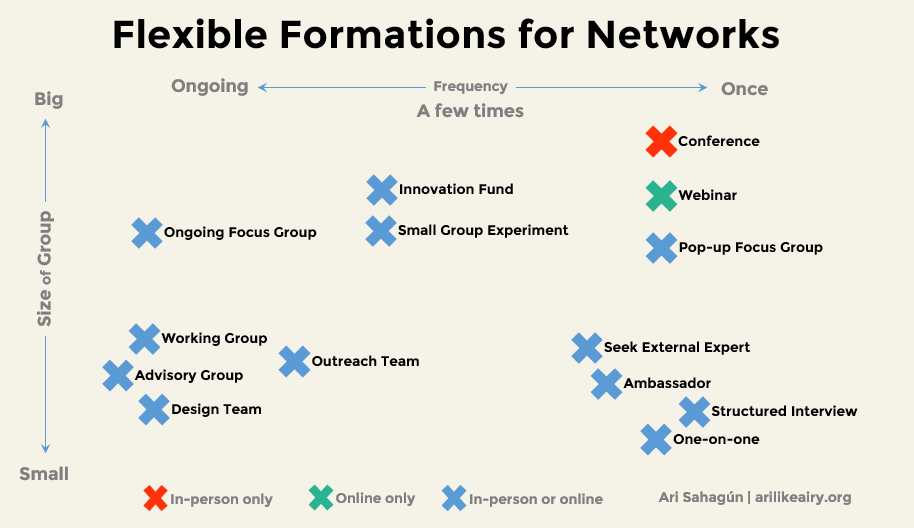Flexible Formations for Networks
[ap_spacing spacing_height="20px"]
Thinking about co-design embedded within a network presents additional challenges. Ideally, a design team creates many spaces to engage in co-design – both online and in-person – that allow for maximum input and creativity as well as respond to shifting levels of availability/capacity to participate.
What follows is a brainstorm I did with my sister, Licia, of the list of formations (groups within a network) that enable this. Furthermore, these formations can be organized from a central group - like a design team - or self-organized as they emerge from network members. [ap_spacing spacing_height="20px"]
[ap_spacing spacing_height="30px"]
| Formation | Definition |
| Advisory group |
Small group that lasts for the length of the project to advise and provide context for the design work; similar to design team but broader
|
| Ambassador |
One person does a one-on-one, then takes on work to do other one-on-ones, or takes information to broader group; “train-the-trainer” might fit here
|
| Conference |
Large group comes together with potential breakout groups, usually in-person
|
| Design team |
An ad hoc group that meets throughout the duration of the project (or sub-scope within it) to provide planning insight
|
| Innovation fund |
Selected group of projects that are funded for specific outcomes
|
| One-on-one |
A conversation between two people
|
| Ongoing focus group |
A representatively diverse group of people assembled to participate in a guided discussion about a particular product before it is launched, or to provide ongoing feedback on a political campaign, television series, etc.
|
| Outreach team |
Spreads the word about design process and reflections to rest of network
|
| Pop-up focus group |
A representative group of people that meets once to provide structured feedback on a specific topic
|
| Seek external expert |
Someone reaches out of core network for advice or thought leadership
|
| Small group experiment |
An ad hoc group that meets to engage with and provide feedback on a project, product, or part of it
|
| Structured interview |
A one-on-one with very specific outcomes
|
| Webinar |
An online lecture with potential Q+A
|
| Working group |
Small group of people who meet regularly with specific outcomes in mind; could be called a committee.
|
[ap_spacing spacing_height="20px"]
We encourage you to comment on this post so we can hear about your thoughts and experience.
[ap_spacing spacing_height="20px"]
Originally published at arilikeairy.org on March 26, 2018
[ap_spacing spacing_height="30px"]
Network Governance
[ap_spacing spacing_height="20px"]
Network governance is the idea that decision-making that is currently lodged in representative bodies such as congress or city councils can be shifted into self-organizing networks. This shift has the potential to massively increase participation and inclusion in policy making and, at the same time, ensure that policy making becomes more innovative, experimental, and capable of learning and transformation. Network governance has the potential to enable all of us to be part of co-creating a world that is good for all of us.[ap_spacing spacing_height="10px"]
Network governance can generate forms of governance that are equitable and inclusive, quick and creative in responding to issues and problems, and capable of tackling the complex and planet-threatening issues of our time.[ap_spacing spacing_height="10px"]
For example, food policy councils, at their best, are cross sector networks that include residents, government and educational representatives, non-profits and food related businesses. They research policy options for things such as rules regarding urban chickens, handling of food waste and support for community gardens, adapt these policies to their locale, and then present policy suggestions to city councils. It seems a small step to empower such councils to make the decisions themselves.[ap_spacing spacing_height="10px"]
Several new developments have made the shift to network governance possible.[ap_spacing spacing_height="25px"]
Self-organizing structures[ap_spacing spacing_height="15px"]
First, new self-organizing structures for network governance are being piloted. These include organizing decision-making into (usually small) work groups called circles: a small, diverse set of individuals who interact as peers and who care deeply about an issue take responsibility for a specific policy initiative - anyone can join the circle. The circle researches the issue and often engages many additional people in a co-design process to generate a draft policy proposal (through the use of technology which is discussed in the following section). Governance networks may have hundreds of circles operating at any one time, with many people involved in more than one circle. [ap_spacing spacing_height="25px"]
Innovative decision-making processes[ap_spacing spacing_height="15px"]
Then the circle uses an innovative decision-making process such as co-design, advice or consent. In the advice process, anyone who would be impacted by the decision has an opportunity (with a deadline) to give feedback on the proposal, which the circle tries to incorporate. The circle has final decision-making power, though if the proposal is controversial the time set to review the policy will be short. The idea is to try something out that is “good enough for now.” [ap_spacing spacing_height="20px"]
[ap_spacing spacing_height="20px"]In co-design or co-creation processes, diverse participants come together and design a new way of doing something, with decision-making woven into the design process, which then moves directly into a pilot phase. For example, a group of residents and organizations may join together to set up a new structure, such as an Innovation Fund that provides seed funds to community projects. This expands the definition of policy making to any collaborative act that contributes to community co-creation. Sometimes co-design is combined with advice or consent processes.[ap_spacing spacing_height="10px"]
Circles and advice/consent processes are currently being used in hundreds of innovative businesses and are now being piloted in a increasing number of networks.[ap_spacing spacing_height="25px"]
Helping participants shift to network values[ap_spacing spacing_height="15px"]
Network governance only becomes transformative when the underlying culture shifts. Network values/behaviors include interacting as peers, dismantling hierarchy and racism, embracing diversity and inclusion, letting go of control, becoming comfortable with uncertainty, seeing everything as an experiment, having space for reflection and learning. Network participants are much more likely to be able to make these shifts in the intimacy of circles, where they can track their progress on these through simple group surveys, then get support for change.[ap_spacing spacing_height="15px"]
The use of technology[ap_spacing spacing_height="10px"]
Next, the use of technology is making cross sector participation possible. Using zoom video conferencing sessions with breakout rooms for discussion combined with the use of google docs for gathering ideas, reflections and feedback makes involvement of many people possible. This can be combined with prioritizing and polling platforms such as sli.do and platforms such as loomio and participative budgeting platforms. In addition, innovators such as vTawain have used other platforms such as polis.[ap_spacing spacing_height="15px"]
Networks of networks[ap_spacing spacing_height="10px"]
The third development is the development of networks of networks for sharing, spreading and learning. These networks of networks are often focused on a specific issue area. For example, the hundreds of food policy councils in the U.S. have state networks, and the state networks are linked through a national network. Both state and national networks have frequent virtual (and occasional face-to-face) learning sessions where they share insights and strategies about specific policy areas and about other topics of relevance. Other networks of networks are perfecting communities of practice or learning clusters so networks are supported in their efforts to do system shifting work. [ap_spacing spacing_height="10px"]
Other networks of networks are convened around cross cutting issues or are bringing people from different (sometimes related) issue areas together for more systemic understanding. For example, Robert Wood Johnson Foundation has been convening networks working on different system elements it calls the Culture of Health (food access, housing, wellbeing, prison pipelines, etc). Other networks of networks are convening to learn more about networks and transformation or about racial justice and equity. These create pathways for viralness, large scale impact and transformation. For example, the use of zoom has spread through the nonprofit world at lightning speed, dramatically increasing the amount of collaboration happening.[ap_spacing spacing_height="15px"]
What would it look like?[ap_spacing spacing_height="10px"]
Imagine policy councils for every aspect of life: housing, health, recreation, education, etc. with most people involved in 2-3 circles at a time but providing advice on dozens or hundreds of proposals a year.
Most governance networks are likely to be local or regional. However, it would be exciting to explore how the networks of network might work nationally and internationally to solve huge, complex problems.[ap_spacing spacing_height="15px"]
How do we get there?[ap_spacing spacing_height="10px"]
Many networks already exhibit some but not all of the characteristics of network governance. By working as a catalyst network, we can help interested networks move to a more complete network governance form. We can create a network of networks interested in moving their networks to the next level and jointly develop a model of key elements of network governance, including case studies of network governance in practice.[ap_spacing spacing_height="10px"]
Also see https://docs.google.com/presentation/d/1I77C0T0UH5b0ZrMsb-QiIBjJkT1G1LlmotrQa1iK1jE/edit?usp=sharing
[ap_spacing spacing_height="25px"]
We encourage you to comment on this post so we can hear about your thoughts and experience. [ap_spacing spacing_height="40px"]



